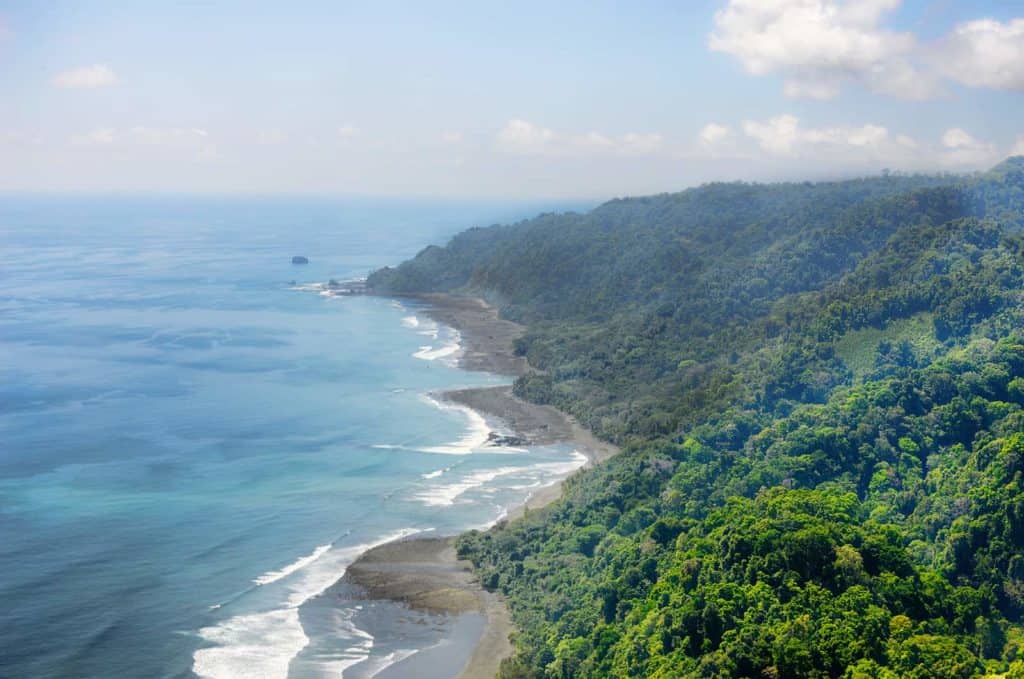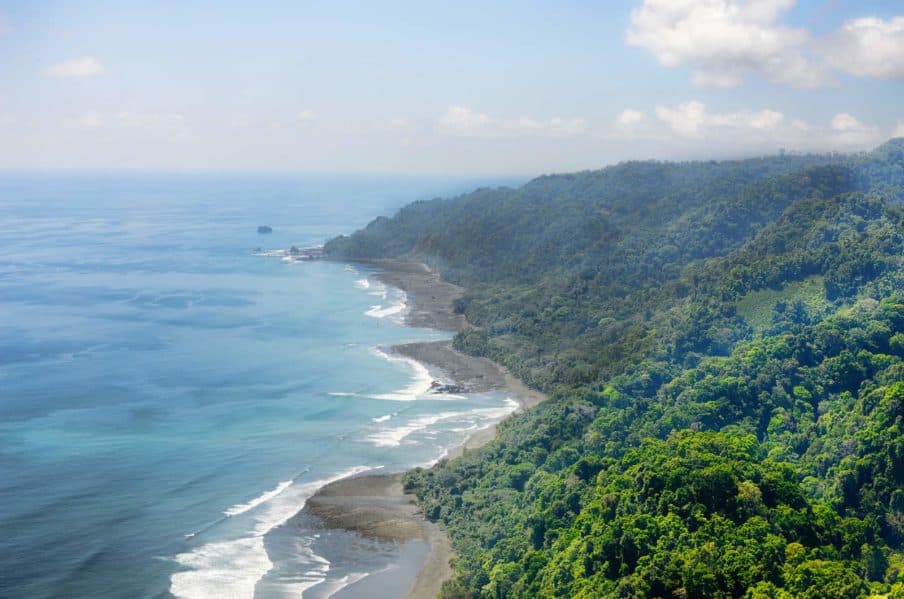
Corcovado National Park, tucked away on Costa Rica’s Osa Peninsula, is a raw slice of nature’s finest work. Often dubbed one of the planet’s most biodiverse places by National Geographic, this 164-square-mile park teems with wildlife, untouched rainforests, and amazing beaches.
If you’re headed to Costa Rica and want to experience its wild side, Corcovado is non-negotiable. This guide breaks down the park’s highlights, from its jaw-dropping biodiversity to hiking trails and practical tips for your visit, complete with a table to help plan your adventure.
Why Corcovado National Park?
Corcovado is a biodiversity powerhouse, protecting 2.5% of the world’s species in a compact area. You’ll find 140 mammal species, 370 bird species, and over 10,000 types of insects. Jaguars, tapirs, scarlet macaws, and all four Costa Rican monkey species—howler, spider, squirrel, and white-faced capuchin—roam its trails. The park spans lowland rainforests, cloud forests, mangrove swamps, and coastal beaches, creating a patchwork of habitats that support an incredible range of life.
Its remote location keeps crowds thin, offering a rare chance to disconnect and soak in nature. Whether you’re trekking through jungle, snapping photos of colorful birds, or chilling on a deserted beach, Corcovado feels like stepping into a wildlife documentary.
Getting to Corcovado National Park
Corcovado’s isolation is part of its charm, but it takes effort to reach. Puerto Jiménez and Drake Bay are the main gateways, accessible from San José, Costa Rica’s capital. Here’s how to get there:
- By Air: Domestic flights from San José to Puerto Jiménez or Drake Bay take about 45 minutes. Sansa and Nature Air run daily routes. From either town, book guided tours or transport to the park’s entrance.
- By Car: Driving from San José to Puerto Jiménez is an 8-hour, 230-mile trip. Roads are mostly paved but can get rough, especially in the rainy season. A 4WD is a must for the final leg to Carate, a key entry point for hikers.
- By Boat: Many reach the park’s Sirena Ranger Station by boat from Drake Bay. The hour-long ride offers coastal views and possible dolphin or whale sightings.
Since 2014, licensed guides are mandatory for all visitors, so booking a tour simplifies entry. Permits are required and can be arranged through your guide or operator. Reserve early, especially for the peak season (December to April), as daily visitor caps are tight.
Best Time to Visit
Corcovado’s tropical climate brings warm temperatures and high humidity year-round. The dry season (December to April) is prime time—trails are less muddy, and wildlife gathers near water sources, making sightings easier. January to April is ideal for camping with clearer skies and milder afternoons.
The rainy season (May to November) means frequent showers and trickier hiking due to swollen rivers. But it’s quieter, and the forest is at its greenest. Wildlife can be more active in the cooler, wetter conditions. October is the wettest month, often leading to park closures, so check ahead.
Hiking Trails in Corcovado
Hiking is the core of any Corcovado trip, with trails winding through jungle, along coasts, and past waterfalls. Here are the top routes:
- Sirena to Los Patos: A 12-mile beast through primary rainforest, perfect for spotting tapirs, monkeys, or even jaguars. It’s a 6-8 hour slog and demands solid fitness.
- La Leona to Sirena: This 10-mile coastal trail from Carate mixes beach and jungle. Expect river crossings, scarlet macaws, and sea turtles. It’s moderately tough, taking 5-7 hours.
- San Pedrillo Station Trails: Short 1-3 mile loops to waterfalls and forest paths, great for beginners. Ideal for day trips from Drake Bay, with toucans and sloths aplenty.
- Los Patos to Sirena: A rugged 12-mile inland route with multiple river crossings. Less crowded, it dives deep into the rainforest and takes 7-9 hours.
Guides are required for all trails, helping you navigate and spot wildlife. River crossings can be dicey at high tide or in the rainy season, so check tide tables at ranger stations. Pack sturdy shoes, water, and rain gear for sudden weather shifts.
Trail Comparison Table
| Trail | Distance | Duration | Difficulty | Highlights |
|---|---|---|---|---|
| Sirena to Los Patos | 12 miles | 6-8 hours | Hard | Rainforest, jaguars, tapirs |
| La Leona to Sirena | 10 miles | 5-7 hours | Moderate | Beaches, macaws, sea turtles |
| San Pedrillo Station | 1-3 miles | 1-3 hours | Easy | Waterfalls, toucans, sloths |
| Los Patos to Sirena | 12 miles | 7-9 hours | Hard | Deep jungle, river crossings |
This table helps you pick a trail based on time, fitness, and what you want to see. For example, if you’re short on time, San Pedrillo’s shorter loops are a solid bet. If you’re up for a challenge, Sirena to Los Patos delivers serious wildlife payoffs.
Wildlife and Photography
Corcovado’s biodiversity is a magnet for wildlife enthusiasts and photographers. You might glimpse elusive jaguars, pumas, or ocelots, though they’re shy. Baird’s tapirs, giant anteaters, and sloths are more common. The skies buzz with scarlet macaws, hummingbirds, and harpy eagles, among the world’s mightiest raptors.
Photographers will find endless material in the park’s vivid colors and dramatic settings. Capture monkeys in towering kapok trees, butterflies among orchids, or crocodiles on riverbanks. Coastal beaches, framed by palms and waves, make stunning sunrise shots. A zoom lens is key for wildlife, and a waterproof camera bag protects gear from rain.
Guides use telescopes to spot distant animals, and early morning hikes offer the best light and activity. Start early to catch the forest at its liveliest.
Beaches and Relaxation
Corcovado’s 23 miles of coastline are a draw, with desolate beaches like Llorona and Madrigal offering soft sands and clear waters. They’re perfect for a post-hike break. Swimming is possible in some areas, but check with rangers—riptides, crocodiles, and bull sharks lurk in estuaries like Ríos Claro and Sirena.
Remote beaches, reachable only by trail or boat, are quieter. With coconut palms and rainforest backdrops, they’re ideal for unwinding. No lifeguards or facilities exist, so bring water and sunscreen.
Conservation and Sustainable Tourism
Since its founding in 1975, Corcovado has been a conservation success story, protecting one of the last lowland tropical forests on the Pacific coast. It faced logging and mining threats until ecologists and President Daniel Oduber secured its status. Today, strict visitor limits and eco-friendly practices minimize impact and support local communities.
The park partners with residents, researchers, and environmental groups to monitor biodiversity and curb poaching. By choosing guided tours and eco-lodges, your visit fuels these efforts. Stick to trails, avoid feeding wildlife, and pack out trash to keep Corcovado pristine.
Where to Stay
Accommodations range from basic to comfortable, inside and outside the park:
- Inside the Park: Sirena Ranger Station has dormitory-style beds, bathrooms, and a small cafeteria. Camping is available at select stations with potable water and limited shelters. Book early—spots go fast.
- Eco-Lodges: Puerto Jiménez and Drake Bay offer immersive stays at places like Lapa Rios or Danta Corcovado Lodge. These often include tours and transfers.
- Budget Stays: Hostels and guesthouses in Puerto Jiménez are affordable for day trippers. Carate has basic lodges for La Leona trail hikers.
Multi-day tours with Sirena stays, run by operators like Osa Wild or Surcos Tours, include meals, guides, and permits for a hassle-free experience.
Practical Tips
- Pack Light: Bring quick-dry clothes, insect repellent, sunscreen, and a reusable water bottle. A dry bag protects electronics during rain or river crossings.
- Stay Safe: Heed your guide, especially near wildlife or water. Watch for snakes like the fer-de-lance, and avoid unverified swimming spots.
- Respect the Park: Stay on trails, don’t feed animals, and take all trash. Small actions protect fragile ecosystems.
- Budget: Day trips run $80-100 per person; multi-day tours are $500-700. Add flights, lodging, and meals for $150-300 daily.
- Connectivity: Cell service is weak, and Wi-Fi is rare. Embrace the digital detox.
Final Thoughts
Corcovado National Park is a rare chance to experience nature at its wildest. From rugged hikes and wildlife encounters to serene beaches, it’s a destination that delivers. Its conservation efforts ensure this gem stays intact for years to come.

